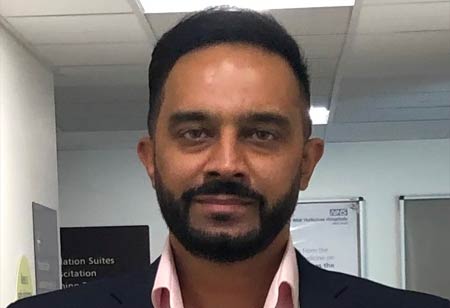Thank you for Subscribing to Healthcare Business Review Weekly Brief

Advancing Patient Safety Through Technology And Collaboration
Healthcare Business Review
Career Journey And Role Evolution
After graduating with a degree in Computer Science, I joined Mid Yorkshire Teaching NHS Trust to develop and implement the Datix patient safety system. This initial role not only allowed me to leverage my technical expertise but also deepened my interest in the critical field of patient safety.
In 2017, I progressed to the role of Patient Safety Development Manager, where I played a key part in advancing the Trust’s systems and processes to enhance safety and quality. During this time, I worked on initiatives that supported embedding a culture of safety and learning across the organisation.
In my most recent role as Patient Safety Intelligence Manager, I have been part of the team responsible for introducing the Patient Safety Incident Response Framework (PSIRF) at the Trust. I also led the successful rollout of the Learning from Patient Safety Events (LFPSE) initiative, ensuring the Trust is compliant with NHSE regulations which will enable the Trust to effectively share lessons from incidents and implemented to improve outcomes at local and national level. These experiences have placed me at the forefront of innovation and development in patient safety, allowing me to contribute meaningfully to the ongoing improvement of care at Mid Yorkshire Teaching NHS Trust.
Technological Advancements in Patient Safety
Technological advancements have significantly transformed how we approach patient safety initiatives; driving efficiency, accuracy, and timely interventions. When I first joined the Trust, patient safety incidents were reported using a paper-based system. This manual process required incidents to be recorded on paper forms and later inputted manually, which made monitoring themes and trends labour-intensive and time-consuming. Communication of patient safety concerns across departments or to the Trust Board was delayed, limiting the ability to act quickly to prevent harm.
The introduction of electronic incident reporting systems was a turning point. This advancement revolutionised how quickly and effectively patient safety concerns were identified, communicated, and addressed. With electronic reporting, incidents could be reported in real time, enabling faster notifications to departments and leadership. This speed allowed for immediate action, quick learning, and the implementation of preventive measures to safeguard patients under our care.
Demonstrating Dedication To Patient Safety Will Inspire Others And Reinforce The Importance Of A Safety-First Mindset
Moreover, electronic reporting facilitated better data collection and analysis, providing insights into recurring themes and trends that inform clinical decision-making. It enabled a culture of accountability and learning. The system also streamlined the feedback loop, ensuring staff received timely updates about the outcomes of their reports, reinforcing their critical role in improving patient care and safety.
Ultimately, this integration of technology into patient safety initiatives has enhanced the quality of care, reduced risks, and strengthened the overall safety culture within the organisation. By embracing technological tools, we’ve not only improved the efficiency of reporting but also created a more resilient and responsive framework for protecting patients.
Digitalised patient safety initiatives play a transformative role in enhancing outcomes and overall patient satisfaction by leveraging technology to create safer, more efficient, and patient-centred care environments.
I think digitalisation has improved incident reporting and response times, this leads to reducing the likelihood of harm and demonstrate a commitment to patient safety. We at Mid Yorkshire have experienced this when we compare our patient safety data to previous years, prior to the introduction of electronic reporting in the organisation, we reported an average of 6,000 incidents in a year. However once we introduced electronic reporting this increased to over 18,000 and continues to grow. 98% of these incidents are near miss/ no harm. This demonstrates an active and learning patient safety culture.
Advice For Aspiring Patient Safety Professionals
For aspiring professionals looking to make a positive impact in the patient safety arena, my advice would centre on several key areas.
Creating a culture of patient safety is fundamental. Aspiring professionals should work towards cultivating an environment where safety is a shared responsibility among all staff. This means encouraging open communication; where nursing, medical staff, and other healthcare professionals feel supported in reporting errors or near misses without fear of blame. Also, be that supportive ear, listen to staff and reach out to support staff who may have been involved in a patient safety event. You may not be able to take all immediate actions, however it will demonstrate compassionate collaboration.
Also, successful patient safety initiatives require the cooperation and input of both nursing and medical staff, at Mid Yorkshire, we engage in collaborative efforts, participate in safety committees, and seek advocates from nurses and doctors who are already involved in quality improvement initiatives. Engage in continuing education, attend workshops, and become familiar with tools/frameworks such as Patient Safety Incident Response Framework (PSIRF), Systems Engineering Initiative for Patient Safety (SEIPS). Data is at the heart of patient safety. Aspiring professionals should develop skills in data analysis and use evidence-based practices to drive improvements.
Lastly, be a role model for safety practices. Show commitment to patient safety in your daily actions, whether it’s through adherence to protocols, promoting hand hygiene, or participating in safety huddles. Demonstrating dedication to patient safety will inspire others and reinforce the importance of a safety-first mindset.
In summary I would advise – “Empower Collaboration, Drive Improvement, Prioritise Patient Safety.”









